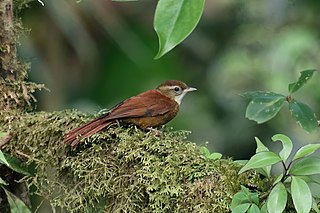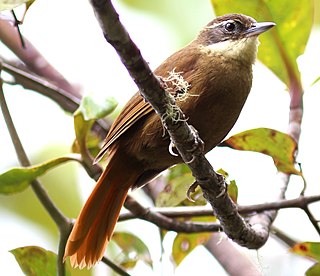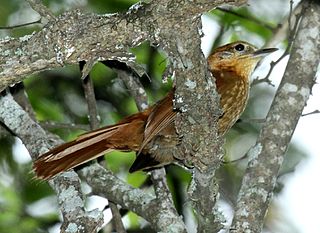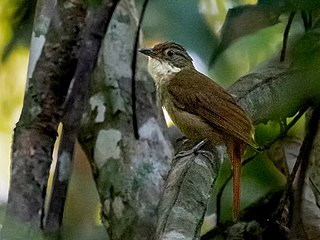
The ruddy treerunner, is a passerine bird in the Furnariinae subfamily of the ovenbird family Furnariidae. It is found in Costa Rica and Panama.

The montane foliage-gleaner is a species of bird in the Furnariinae subfamily of the ovenbird family Furnariidae. It is found in Bolivia, Colombia, Ecuador, Peru, and Venezuela.

The scaly-throated foliage-gleaner, also known as the spectacled foliage-gleaner, is a species of bird in the Furnariinae subfamily of the ovenbird family Furnariidae. It is found in Mexico, in every Central American country except Nicaragua, and in Colombia and Ecuador.

The olive-backed foliage-gleaner is a species of bird in the Furnariinae subfamily of the ovenbird family Furnariidae. It is found in every mainland South American country except Argentina, Chile, Paraguay, and Uruguay.

The white-eyed foliage-gleaner is a species of bird in the Furnariinae subfamily of the ovenbird family Furnariidae. It is found in Argentina, Brazil, and Paraguay.

The ochre-throated foliage-gleaner is a species of bird in the Furnariinae subfamily of the ovenbird family Furnariidae. It is found in Panama and every mainland South American country except Argentina, Chile, Paraguay, and Uruguay.

The tepui foliage-gleaner, also known as the white-throated foliage-gleaner, is a species of bird in the Furnariinae subfamily of the ovenbird family Furnariidae. It is found in Brazil, Guyana and Venezuela.

The chestnut-crowned foliage-gleaner is a species of bird in the Furnariinae subfamily of the ovenbird family Furnariidae. It is found in Bolivia, Brazil, Colombia, Ecuador, French Guiana, Guyana, Peru, Suriname, and Venezuela.

The canebrake groundcreeper is a species of bird in the Furnariinae subfamily of the ovenbird family Furnariidae. It is found in Argentina, Brazil, and Paraguay.

The henna-capped foliage-gleaner or chestnut-capped foliage-gleaner is a species of bird in the Furnariinae subfamily of the ovenbird family Furnariidae. It is found in Brazil and Paraguay.

The planalto foliage-gleaner, also known as the russet-mantled foliage-gleaner, is a species of bird in the Furnariinae subfamily of the ovenbird family Furnariidae. It is found in Brazil and Paraguay.

The rufous-rumped foliage-gleaner is a species of bird in the Furnariinae subfamily of the ovenbird family Furnariidae. It is found in Bolivia, Brazil, Colombia, Ecuador, French Guiana, Guyana, Peru, and Suriname.

The slaty-winged foliage-gleaner is a species of bird in the Furnariinae subfamily of the ovenbird family Furnariidae. It is found in Colombia, Ecuador, and Panama.

The guttulate foliage-gleaner is a species of bird in the Furnariinae subfamily of the ovenbird family Furnariidae. It is endemic to Venezuela.

The rufous-necked foliage-gleaner is a Vulnerable species of bird in the Furnariinae subfamily of the ovenbird family Furnariidae. It is found in Ecuador and Peru.

The lineated foliage-gleaner is a species of bird in the Furnariinae subfamily of the ovenbird family Furnariidae. It is found in Colombia, Costa Rica, Ecuador, Panama, Peru, and Venezuela.

The Para foliage-gleaner is a species of bird in the Furnariinae subfamily of the ovenbird family Furnariidae. It is endemic to Brazil.

The Santa Marta foliage-gleaner is a Vulnerable species of bird in the Furnariinae subfamily of the ovenbird family Furnariidae. It is endemic to Sierra Nevada de Santa Marta in Colombia.

The Chiriqui foliage-gleaner is a species of bird in the Furnariinae subfamily of the ovenbird family Furnariidae. It is found in Costa Rica and Panama.

The fawn-throated foliage-gleaner is a species of bird in the Furnariinae subfamily of the ovenbird family Furnariidae. It is found in Belize, Costa Rica, Guatemala, Honduras, Mexico, Nicaragua, and Panama.























